Siddington
OS grid ref:-
 The attractive Cheshire village of Siddington is situated on the A34 road to the north of Congleton.
The attractive Cheshire village of Siddington is situated on the A34 road to the north of Congleton.
The Capesthorne Hall Estate lies within the village. The red brick turreted hall was built in the Jacobean style between 1719 and 1732, the turrets and pinacles were added a hundred years later. The hall has been the family home of the Bromley-Davenport family since 1726. The interior boasts a fine collection of antique furniture, art, marble sculpture, and tapestries as well as a treasured collection of Americana and children's toys, greek vases and family muniments dating from 1153.
Redesmere Lake on the Capesthorne estate at Siddington stretches for half a mile and is used for sailing. There are large flocks of mallard on the lake, as well as Canada geese, moorhen, and tufted duck, mute swan, great crested grebe, can all be spotted, while pochard, ruddy duck, shoveller, and goldeneye and kingfisher may be seen occasionally. Some rare species , such as smew have been known to visit. Resident species in the woodland include chaffinch, nuthatch, treecreeper, wren, great spotted woodpecker and little and tawny owls.
The Redesmere Fete takes place the last Saturday in July, from 1.30pm to Midnight, and begins when the Waterlily Queen is rowed across Redesmere in her swan-shaped boat for her coronation. The fete continues at Siddington Village Hall right through to midnight.
All Saints Church, Siddington

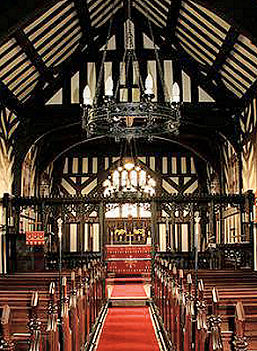 All Saints Church at Siddington is said to have been founded in the fourteenth century although the first documentary evidence dates from 1474 when the church was mentioned in the will of Robert Sydington . It may have been a chapel of ease for Prestbury, or possibly a domestic chapel for the Fittons of Siddington Hall.
All Saints Church at Siddington is said to have been founded in the fourteenth century although the first documentary evidence dates from 1474 when the church was mentioned in the will of Robert Sydington . It may have been a chapel of ease for Prestbury, or possibly a domestic chapel for the Fittons of Siddington Hall.
The church is constructed of timber framework, with wattle and daub filling and a roof of Macclesfield Slabs. Unfortunately a lot of the timberwork was demolished in the eighteenth century to be replaced by brick, to support the heavy stone slab roof, which replaced the original thatched roof.
The chancel walls consist of the original timber-framing while the brickwork of the nave is now painted black and white to simulate a timber framed pattern.
The interior contains a handsome carved fourteenth century screen, which is topped with corn dollies. There are also some fine stained glass windows inside the church and an illuminated panel which commemorates ceremony of blessing the animals, which in former times was held at All Saints.
The west bell turret houses a bell which was cast in 1588 to sound the alarm if the Spanish Armada proved successful. The church also has some very attractive stained glass windows.
In the chuchyard are the graves of the Bromley-Davenport family of Capesthorne Hall, there are also a pair of simple white crosses commemorating two Canadian airmen who died at Thorneycroft Hall in 1918 when their light aircraft struck a flagpole and crashed.
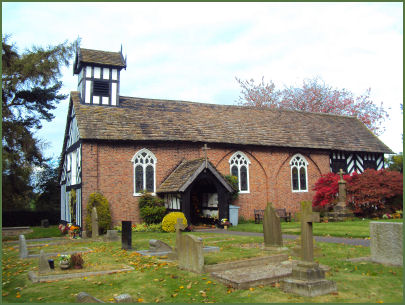
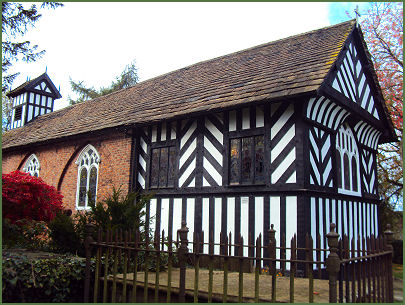
The Harvest Festival at Siddington Church
At the annual harvest festival, each October, All Saint's church is filled with thousands of corn dollies and the building is decorated with fruit, vegetables, flowers. The corn dolly maker, dairy farmer and local historian Raymond Rush, lives at the farm near to the church and sometimes sells corn dollies from his workshop.
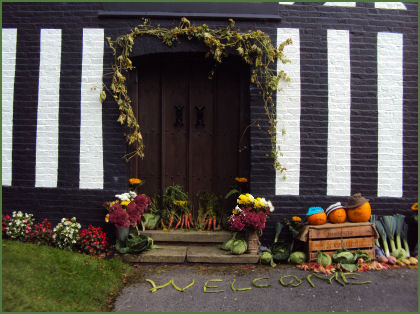

The making of corn dollies, sometimes known as corn mothers or corn maidens, is the craft of weaving stems and even heads of 'corn' into decorations and dates back many thousands of years. The craft was brought to a halt by the advent of mechanization in the 1800s.
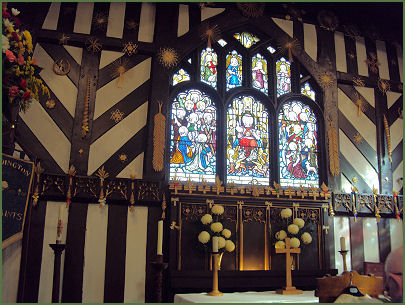

In pre-Christian culture it was believed that the spirit of the corn lived amongst the crop, and that the harvest made it effectively homeless. Shapes were made from the last sheaves of the harvest. The ‘corn spirit’ would then spend the winter in this home until the ‘corn dolly’ was ploughed into the first furrow of the following spring. The word "Dolly" may be a corruption of "idol" or may have derived directly from the Greek word eidolon (apparition), that which represents something else. As in many prehistoric traditions that have survived in some form to the present day the early Christian church appropriated the custom and practice.
Nearby places of interest
Gawsworth Hall is a late fifteenth century half timbered manor house built around a courtyard. The house belonged to the Fitton family, Earls of Macclesfield. The hall contains many fine paintings, furniture, sculpture and stained glass. An earlier house once occupied the site which dated from Norman times. This house was replaced in the 15th and 16th centuries. Building commenced in 1480 and continued in stages until about 1600. Since that time, parts of the building have been demolished, and others have been greatly altered.
Bosley Cloud lies on the Cheshire-Staffordshire border just a couple of miles to the west of the Peak District National Park. It rises to a height of 343 metres (1,125 feet).
